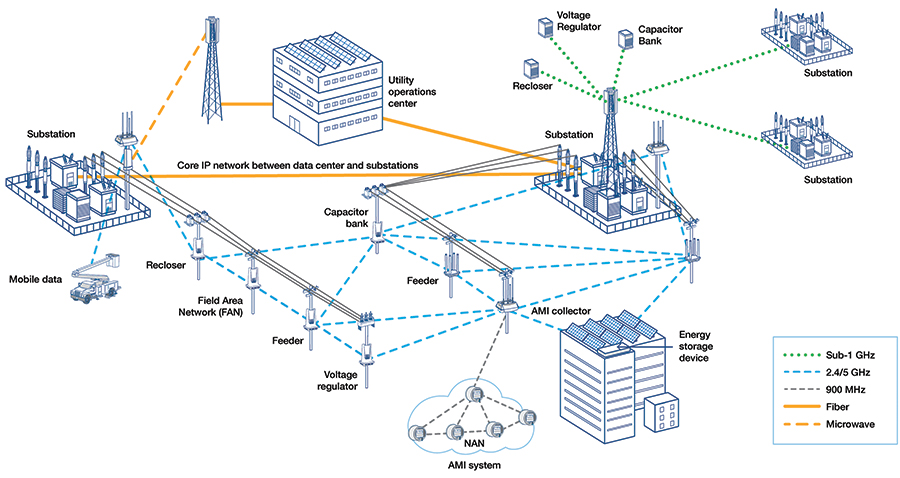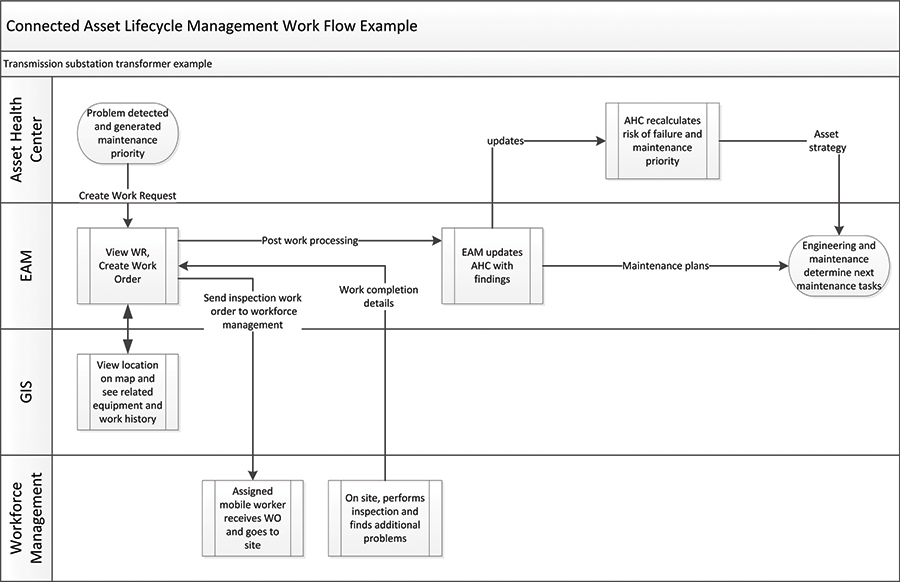Why Connected ALM?
Once upon a time, data gathering was the problem; utilities had no way to see the big picture. With the advent of now-ubiquitous software systems and the rapidly growing convergence of IT and OT, information technology (IT) and operations technology (OT), there is plenty of data. Utilities can see the big picture, but can’t make sense of it. To capitalize on this convergence, utilities need to be able to leverage the information from these diverse sources to get (near) real-time views into the actual conditions of assets on the network. The real challenge is two-fold:
- Consolidating information into a single view of the assets fleet-wide, and
- Extrapolating experience-based performance models and analytics that can alert you to assets trending toward failure and offer guidance on how to best to mitigate the trend before catastrophic failure occurs.
A truly optimized asset lifecycle includes seamless integration of the processes and tools employed to monitor the assets, deploy resources to repair or replace them, and manage the history of the assets and work performed on them (including the associated costs for equipment, spare parts, etc.). This is the very heart of the Connected Asset Lifecycle Management ™ (ALM) approach: bringing together individual technology solutions such as asset performance management (APM), workforce management (WFM), and enterprise asset management (EAM) to deliver a holistic view of the asset lifecycle (see Figure 1).
And, of course, usable data are like gold; the more you have the better. As these massive amounts of information are captured, stored and analyzed in a multi-step process that constantly rides the Internet or a private network, it fuels the need for greater bandwidth. And as the adage goes, “you’re only as strong as your weakest link,” so those utilities that have not upgraded their field area networks (FANs) will find themselves at a competitive disadvantage.
Connected ALM is more than the sum of the individual work and asset management systems – although each of these components plays a vital role:

Figure 1: Connected ALM (Source: ABB)
Asset performance management solutions enable utilities to evaluate assets at the intersection of criticality to the business and the probability of failure, then effectively act on prescribed scenarios that are optimally prioritized to capture game-changing value. These solutions can seamlessly extract data into one enterprise environment, compare the critical nature of assets against experience-based probability models, and enable utilities to act on prescribed intelligence to boost asset-, plant- and fleet-level performance and efficiency.
Workforce management solutions provide resource optimization capabilities so that field resources are dispatched with all the required tools, information, and parts at the promised time based on asset condition. Advanced WFM products ensure that schedules are optimized based on customer or asset demands, travel times, service level agreements, technician skills requirements, and internal costs.
Enterprise asset management solutions allow for the effective management of assets, work orders, inventory, and purchasing – all within the confines of safety and regulatory compliance. These solutions consider the skills needed, processes required and dependencies for parts, equipment, and documentation. In this case, decisions are driven by asset condition, availability of spares, project risk, and financial considerations.

Figure 2: A full range of communications solutions is required to enable a truly Connected ALM approach. (Source: ABB)
(click to enlarge)
Modern Wireless Communication Networks can replace siloed communications links or organize them into a two-way communications network that is reliable, secure, and addresses the spectrum of IT/OT convergence use cases from advanced meter infrastructure (AMI) to distribution automation (DA); enabling utilities to build for the bandwidth demands of today and ensure the sustainment for the next decade (see Figure 2).
All of these solutions optimize critical functional requirements very effectively – but they do it individually. The Connected ALM approach leverages their individual strengths to achieve transformational performance by eliminating disjointed workflows, organizational boundaries, and information silos, thereby enabling electrical distribution utilities to:
- Better manage risk and safety
- Leverage the cloud and mobility
- Enhance asset integrity, maintenance and reliability,
- Ensure regulatory compliance
What differentiates Connected ALM from other work and asset management approaches?
To comprehend the power of the Connected ALM approach, it’s important to understand that Connected ALM includes all aspects of “service.” Connected ALM considers the broad context of managing the customer, asset, and workforce business processes – including design and construction, maintenance, wide area network (WAN), and FAN channels, as well as critical organizational reporting and utility metrics.
What differentiates a true Connected ALM approach is the ability to enable (near) real-time performance management (RPM) – the capability to push key analytics at the right time so that critical decisions can be made in an automated and intelligent manner. RPM provides a series of performance metrics around customer loyalty, asset optimization, workforce efficiency, supply chain optimization, and financial management. With RPM, users view and analyze key performance indicators to proactively – even predictively – improve efficiency and minimize costs throughout the operation. Without a platform that connects the information and processes in a seamless manner, RPM is not possible.
How does Connected ALM work?
Perhaps the best way to communicate the transformational benefits of the Connected ALM approach is to consider an example scenario at a transmission and distribution (T&D) utility. Our subject is a large electric utility with thousands of miles of transmission lines and thousands of substations across several states. Much of the infrastructure is aging, with many assets (e.g., transformers, circuit breakers, batteries, etc.) a mismatched collection of brands, topologies, and Field Area Networks (FANs) nearing their end of life.
This has led to a drastic increase in complexity for the utility, creating big challenges when it comes to management, security, scalability, and cost efficiency:
- Making decisions to replace or repair the assets
- Determining how to move beyond time- and usage-based inspections
- Attaining visibility of near real-time operating conditions of vital assets
- Meeting evolving compliance requirements
- Managing retirement of skilled technicians
- Holding down operations and maintenance (O&M) costs
With a Connected ALM approach, seamlessly integrated APM, EAM, and WFM systems enable a highly efficient workflow (see Figure 3).

Figure 3: Connected ALM optimizes cross-functional processes by enabling efficient workflows across integrated, interdependent systems. (Source: ABB)
(click to enlarge)
As you can see from this example workflow diagram, a fully integrated Connected ALM approach enables efficient workflows across the various systems used to monitor, manage, and continuously optimize the process and people that keep the assets up and running. The value derived from enabling such a seamless workflow can include such benefits as:
- Reducing catastrophic equipment failures through timely asset condition visibility, predictive analytics, and risk modeling
- Prioritizing maintenance and replacement to reduce both failures and O&M costs
- Optimizing asset investment strategies through comprehensive and accurate asset condition information
- Improving maintenance prioritization and planning, delivering greater productivity from both people and equipment
- Enhancing safety for workers, the public, and the environment
- Improving regulatory compliance and reporting with automated data capture, analysis, and report generation
- Increasing operational efficiency by linking operations to predictive maintenance and mobile workforce management systems
Is a Connected ALM approach possible today?
Absolutely. The only thing standing in the way of bringing the Connected ALM approach to any organization is the decision to do it. It is an investment – of money and time, certainly, not to mention the critical underlying network – but, the real investment is in the health of your business.
It is important to remember that Connected ALM is not just about systems but also people and processes. Implementing Connected ALM requires deep domain expertise and an understanding of the complex workflows across a T&D organization in order to build the necessary integrations. When you make the decision to take the Connected ALM approach, look for partners who have both expertise in electrical distribution and in integrating APM, WFM, EAM and utility communications solutions; this will help facilitate a smooth implementation to achieve the benefits of connection.
About the Authors
 Chris Rittler is responsible for leading the global ABB Wireless business. Mr. Rittler was Vice President of Carrier Sales and Business Development for Tropos Networks from 2002 to 2008, prior to the company’s acquisition by ABB. He was most recently Senior Vice President Sales, Marketing and Business Development for Deluxe Digital Distribution and has also held leadership positions at Frontier Communications, Cambia Networks and Motorola. Mr. Rittler has led teams responsible for delivering to market industryleading, high-technology products for telecommunications, including wireless communications for cellular voice, broadband wireless data and IPTV. He has more than 20 years of leadership experience building successful global businesses through a blend of strategic, technological and operational strengths. He holds an MBA from Kellogg Graduate School of Management, Northwestern University, an MSEE from the University of Wisconsin-Madison and a BSEE from Marquette University.
Chris Rittler is responsible for leading the global ABB Wireless business. Mr. Rittler was Vice President of Carrier Sales and Business Development for Tropos Networks from 2002 to 2008, prior to the company’s acquisition by ABB. He was most recently Senior Vice President Sales, Marketing and Business Development for Deluxe Digital Distribution and has also held leadership positions at Frontier Communications, Cambia Networks and Motorola. Mr. Rittler has led teams responsible for delivering to market industryleading, high-technology products for telecommunications, including wireless communications for cellular voice, broadband wireless data and IPTV. He has more than 20 years of leadership experience building successful global businesses through a blend of strategic, technological and operational strengths. He holds an MBA from Kellogg Graduate School of Management, Northwestern University, an MSEE from the University of Wisconsin-Madison and a BSEE from Marquette University.
 Rick Nicholson has over 30 years of experience with the intersection of business and technology in the energy industry. He is a recognized and highly respected expert in the alignment of business and technology strategies and the successful deployment of technology to enable business process improvement. Rick has worked with clients in North America, Europe and Asia. His career has included positions with market research, consulting and technology firms where his responsibilities included business development, marketing, strategy, competitive analysis and project delivery. He is currently responsible for global product management and marketing for ABB’s Enterprise Software product group. Rick is a contributing writer and blogger for a variety of energy industry publications, is a regular speaker at industry conferences, has been quoted in mainstream business publications and has been interviewed on national television news programs.
Rick Nicholson has over 30 years of experience with the intersection of business and technology in the energy industry. He is a recognized and highly respected expert in the alignment of business and technology strategies and the successful deployment of technology to enable business process improvement. Rick has worked with clients in North America, Europe and Asia. His career has included positions with market research, consulting and technology firms where his responsibilities included business development, marketing, strategy, competitive analysis and project delivery. He is currently responsible for global product management and marketing for ABB’s Enterprise Software product group. Rick is a contributing writer and blogger for a variety of energy industry publications, is a regular speaker at industry conferences, has been quoted in mainstream business publications and has been interviewed on national television news programs.







